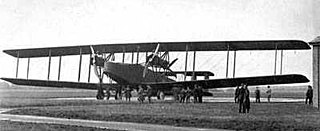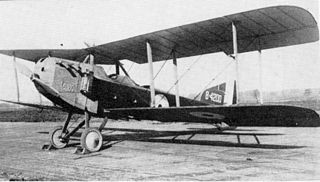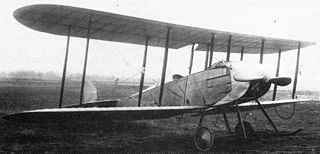
The Sopwith Pup was a British single-seater biplane fighter aircraft built by the Sopwith Aviation Company. It entered service with the Royal Naval Air Service and the Royal Flying Corps in the autumn of 1916. With pleasant flying characteristics and good manoeuvrability, the aircraft proved very successful. The Pup was eventually outclassed by newer German fighters, but it was not completely replaced on the Western Front until the end of 1917. Remaining Pups were relegated to Home Defence and training units. The Pup's docile flying characteristics also made it ideal for use in aircraft carrier deck landing and takeoff experiments and training.

The Handley Page V/1500 was a British night-flying heavy bomber built by Handley Page towards the end of the First World War. It was a large four-engined biplane, which resembled a larger version of Handley Page's earlier O/100 and O/400 bombers, intended to bomb Berlin from East Anglian airfields. The end of the war stopped the V/1500 being used against Germany, but a single aircraft was used to carry out the first flight from England to India, and later carried out a bombing raid on Kabul during the Third Anglo-Afghan War. It was colloquially known within the fledgling Royal Air Force as the "Super Handley". The V/1500 which was shipped to Canada to attempt a transatlantic flight was flown in the US, and in 1919 crash-landed in a field at Mount Jewett, Pennsylvania. Photos appeared in the 20 February 1969 issue of the Bradford Journal newspaper.

Between 1911 and 1914, the Royal Aircraft Factory used the F.E.2 designation for three quite different aircraft that shared only a common "Farman" pusher biplane layout.

The Handley Page Heyford was a twin-engine British biplane bomber of the 1930s. Although it had a short service life, it equipped several squadrons of the RAF as one of the most important British bombers of the mid-1930s, and was the last biplane heavy bomber to serve with the RAF. The first aircraft of the type were deployed at RAF Upper Heyford, near Bicester in Oxfordshire.

The Hawker Horsley was a British single-engined biplane bomber of the 1920s. It was the last all-wooden aircraft built by Hawker Aircraft, and served as a medium day bomber and torpedo bomber with Britain's Royal Air Force between 1926 and 1935, as well as the navies of Greece and Denmark.

The Armstrong Whitworth F.K.3 was a British two-seat general-purpose biplane built by Armstrong Whitworth Aircraft during the First World War. By the end of the war it was considered obsolete for combat.

The Armstrong Whitworth F.K.8 was a British two-seat general-purpose biplane built by Armstrong Whitworth during the First World War. The type served alongside the better known R.E.8 until the end of the war, at which point 694 F.K.8s remained on RAF charge.

The Westland Walrus was a British spotter/reconnaissance aircraft built by Westland Aircraft.

The Avro 549 Aldershot was a British single-engined heavy bomber aircraft built by Avro.

The Airco DH.1 was an early military biplane of typical "Farman" pattern flown by Britain's Royal Flying Corps during World War I. By the time the powerplant for which it was designed was sufficiently plentiful it was obsolete as an operational aircraft, and apart from a few examples sent to the Middle East it served as a trainer and Home Defence fighter.

The Airco DH.6 was a British military trainer biplane used by the Royal Flying Corps during the First World War. Known by various nicknames, including the "Clutching hand" and "Skyhook", many survived to be used as a civil light aircraft in the postwar era.

The Martinsyde G.100 "Elephant" and the G.102 were British fighter bomber aircraft of the First World War built by Martinsyde. The type gained the name "Elephant" from its relatively large size and lack of manoeuvrability. The G.102 differed from the G.100 only in having a more powerful engine.

The Royal Aircraft Factory B.E.12 was a British single-seat aeroplane of The First World War designed at the Royal Aircraft Factory. It was essentially a single-seat version of the B.E.2.

The Maurice Farman MF.11 Shorthorn is a French aircraft developed before World War I by the Farman Aviation Works. It was used as a reconnaissance and light bomber during the early part of World War I, later being relegated to training duties.

The SIAI S.8 was an Italian 1910s two-seat reconnaissance flying boat.

The Nieuport 12 was a French sesquiplane reconnaissance, fighter aircraft and trainer used by France, Russia, Great Britain and the United States during World War I. Later production examples were built as trainers and served widely until the late 1920s.

The Royal Aircraft Factory B.E.8 was a British two-seat single-engined general purpose biplane of the First World War, designed by John Kenworthy at the Royal Aircraft Factory in 1913. Small numbers were used by the Royal Flying Corps over the Western Front in the first year of the war, with the type being used as a trainer until 1916.

The Royal Aircraft Factory R.E.5 was a British two-seat reconnaissance and artillery observation biplane designed and built by the Royal Aircraft Factory for the Royal Flying Corps.

The Vickers F.B.14 was a British two-seat fighter/reconnaissance biplane designed and built by Vickers Limited. About 100 were built for the Royal Flying Corps but saw only limited use as it was designed for a larger engine which was not available when production commenced and it did not meet performance expectations.

The Curtiss C-1 Canada was a twin-engined bomber aircraft of the First World War which was designed by Curtiss of America to be built by their Canadian subsidiary for the British Royal Naval Air Service and Royal Flying Corps. Although large orders were placed, only twelve were built, the type being rejected in favour of more capable aircraft such as the Handley Page O/100.




















